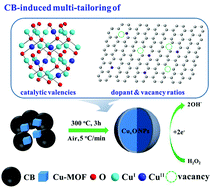Multi-tailoring of a modified MOF-derived CuxO electrochemical transducer for enhanced hydrogen peroxide sensing†
Abstract
Reasonable control of the redox states within the catalytic units together with the interconnection degrees of the substrate is of great significance in the modulation of a well-performing transducer. Herein, a novel carbon black (CB)-modified copper metal–organic framework nanomaterial (CB@Cu-MOF) prepared at room temperature was utilized as a precursor to synthesize mixed-valent copper–oxide composite catalysts (NC/CuxO-T). By tuning the carbonization process of the precursor at different temperatures (T = 100 °C, 200 °C, 300 °C and 400 °C), the different ratio configurations of the redox-alternated CuxO portions were successfully controlled with the simultaneous effective tailoring of the defect abundance in the N-doped carbon substrate. As a result, an optimized NC/CuxO-300 electrochemical H2O2 sensor was able to present a low detection limit (0.26 μM) and decent linear ranges (0.02–1.79 mM and 2.29–9.29 mM). Our strategy using easily available initial materials with mild preparation conditions is expected to promote the practical application of the star materials in laboratories.

- This article is part of the themed collection: Analyst HOT Articles 2021


 Please wait while we load your content...
Please wait while we load your content...